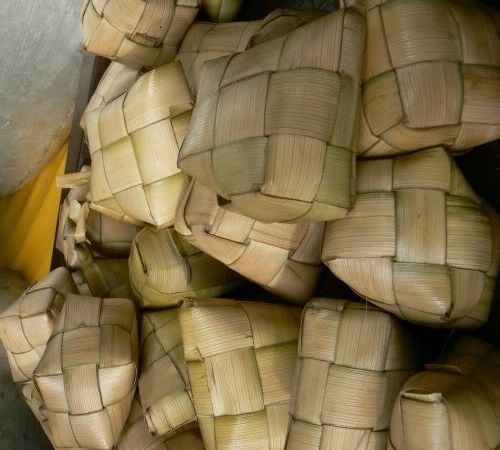Ketupat is a type of dumpling from Indonesia, Brunei, Singapore, Malaysia and the Philippines (where it is known by the name Patupat in Kapampangan Puso in Cebuano), made from rice that has been wrapped in a woven palm leaf pouch which is then boiled. As the rice cooks, the grains begin to expand to fill the pouch and the rice becomes compressed. This method of cooking gives the ketupat its characteristic form and texture of a rice dumpling. Ketupat is usually eaten with rendang (a type of dry beef curry) or served as an accompaniment to
satay. Ketupat is also traditionally served by Indonesians and Malays at open houses on festive occasions such as Idul Fitri (Hari Raya Aidilfitri). During Idul Fitri in Indonesia, ketupat is often served with chicken curry, accompanied with spicy soy powder. Among Filipinos, puso is also traditionally used as a pabaon or a mobile meal, traditionally brought by workers as a type of packed lunch, served with any selection of stews.
In my experience, I've eaten Ketupat Kandangan, a Banjarmasin Traditional Food. Yummy!
There are many varieties of ketupat, with two of the more common ones being ketupat nasi and ketupat pulut. Ketupat nasi is made from white rice and is wrapped in a square shape with coconut palm leaves while ketupat pulut is made from glutinous rice is usually wrapped in a triangular shape using the leaves of the fan palm (Licuala). Ketupat pulut is also called "ketupat daun palas" in Malaysia.
In Indonesia, ketupat sometimes boiled in thin coconut milk and spices to enhance the taste.
In the Philippines, Puso weaving, the weaving of the wrapper of puso, is an ancient Cebuano art. The more popular shapes are binaki (using double strips), binaba (in the shape of a mouth), and kinasing (in the shape of a heart), but there were also other varieties now forgotten, named after their shape. Some of these were the following:
(wikipedia)

satay. Ketupat is also traditionally served by Indonesians and Malays at open houses on festive occasions such as Idul Fitri (Hari Raya Aidilfitri). During Idul Fitri in Indonesia, ketupat is often served with chicken curry, accompanied with spicy soy powder. Among Filipinos, puso is also traditionally used as a pabaon or a mobile meal, traditionally brought by workers as a type of packed lunch, served with any selection of stews.
In my experience, I've eaten Ketupat Kandangan, a Banjarmasin Traditional Food. Yummy!
There are many varieties of ketupat, with two of the more common ones being ketupat nasi and ketupat pulut. Ketupat nasi is made from white rice and is wrapped in a square shape with coconut palm leaves while ketupat pulut is made from glutinous rice is usually wrapped in a triangular shape using the leaves of the fan palm (Licuala). Ketupat pulut is also called "ketupat daun palas" in Malaysia.
In Indonesia, ketupat sometimes boiled in thin coconut milk and spices to enhance the taste.
In the Philippines, Puso weaving, the weaving of the wrapper of puso, is an ancient Cebuano art. The more popular shapes are binaki (using double strips), binaba (in the shape of a mouth), and kinasing (in the shape of a heart), but there were also other varieties now forgotten, named after their shape. Some of these were the following:
- linangbay (crab)
- binaobao (turtle)
- linalaki (masculine)
- binabaye (feminine)
- binituon (star)
- tam (fat)
- sinako (sack)
- bunga gapas (fruit of cotton)
- bayobayo
- tinikod (heel)
- binairan (sharpening tool)
- pinawikan (turtle)
(wikipedia)

0 komentar: